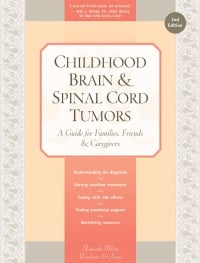Childhood Brain and Spinal Cord Tumors
What is a peripheral blood stem cell transplant?
Bone marrow is the spongy material inside bones. It is full of the youngest type of blood cells—called stem cells—from which all other blood cell types develop (white blood cells, red blood cells, and platelets). Stem cells are also found in circulating (also called peripheral) blood, although in a much less concentrated form.
At present, some types of brain and spinal cord tumors cannot be cured with conventional doses of chemotherapy or radiation. For some of these tumors, the very high doses of chemotherapy needed to kill tumor cells also permanently destroy the normal stem cells in the bone marrow.
There are different types of stem cell transplants. When peripheral blood is used as a source of stem cells for a transplant, it is called a peripheral blood stem cell transplant or PBSCT. If the child does not have cancer cells in the bone marrow, as is the case for children with brain and spinal cord tumors, the child usually is able to donate his own stem cells for a transplant. This type of transplant is called an autologous PBSCT, and this chapter deals specifically with this type of stem cell transplant.
In an autologous PBSCT, the child’s own stem cells are harvested in a procedure called apheresis. After collection and storage of the stem cells, children are given high-dose chemotherapy, followed by an infusion of their own stem cells. See the section entitled “Stem cell harvest and storage” later in this chapter for a description of the collection and storage process.
This process can be done one or more times, allowing doctors to expose the tumor cells to high doses of chemotherapy while limiting toxicity and the risk of life-threatening infections. When this process is done more than once, it is called tandem PBSCT, serial PBSCT, or sequential PBSCT.
Table of Contents
All Guides- Introduction
- 1. Diagnosis
- 2. The Brain and Spinal Cord
- 3. Types of Tumors
- 4. Telling Your Child and Others
- 5. Choosing a Treatment
- 6. Coping with Procedures
- 7. Forming a Partnership with the Treatment Team
- 8. Hospitalization
- 9. Venous Catheters
- 10. Surgery
- 11. Chemotherapy
- 12. Common Side Effects of Chemotherapy
- 13. Radiation Therapy
- 14. Peripheral Blood Stem Cell Transplantation
- 15. Siblings
- 16. Family and Friends
- 17. Communication and Behavior
- 18. School
- 19. Sources of Support
- 20. Nutrition
- 21. Medical and Financial Record-keeping
- 22. End of Treatment and Beyond
- 23. Recurrence
- 24. Death and Bereavement
- 25. Looking Forward
- Appendix A. Blood Tests and What They Mean
- Appendix C. Books and Websites

